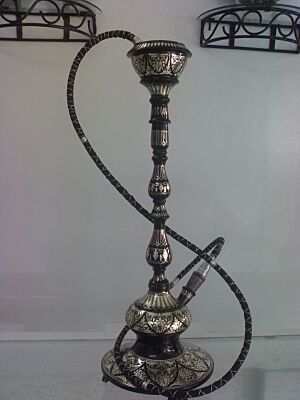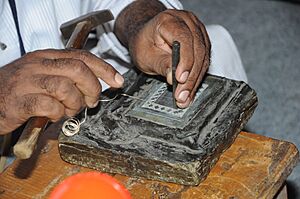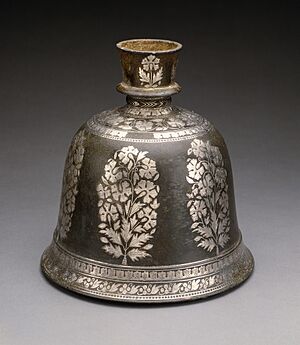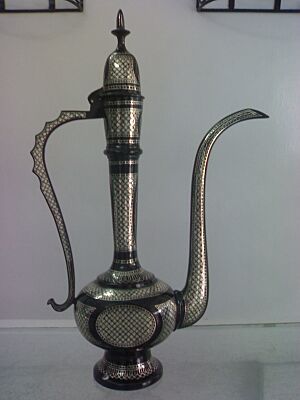Bidriware facts for kids
Bidriware is a special type of metal art from Bidar, a city in Karnataka, India. This unique craft started in the 1300s, during the time of the Bahmani Sultans. The name "Bidriware" comes directly from the city of Bidar, where most of this art is still made today. It uses a metal called white brass, which is then turned black and decorated with shiny silver designs. Bidriware is a very old and important art form from India. It even has a special tag called a Geographical Indications (GI) registry, which it received on January 3, 2006. This tag helps protect its unique origin.
Contents
How Bidriware Began
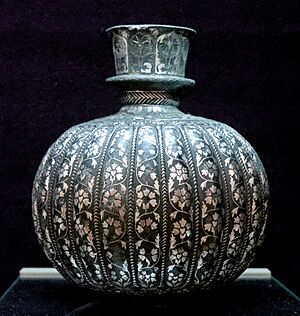
Many people believe Bidriware started with the Bahmani sultans who ruled Bidar in the 1300s and 1400s. The style and methods of Bidriware were influenced by Persian art. This art form grew in a kingdom that blended Turkish, Persian, and Arabic styles with local Indian traditions. This mix created a truly unique art.
A craftsman named Abdullah bin Kaiser from Iran was invited by Sultan Ahmed Shah Bahmani. He came to help decorate the royal palaces and courts. Some stories say that Kaiser worked with local artists. Together, they created Bidriware under the rule of Ahmed Shah and his son, Second Alauddin Bahmani. This special art then spread widely and was passed down through many generations of artists.
Talented Bidri Artisans
Many skilled artists create Bidriware. Some of these artists have even shown their amazing work in other countries.
For example, Syed Tassaduq Hussain was a very important artist. He was the head of the Gulistan Cooperative Society in Bidar in 1961 and won the first National award for Bidriware in 1969. Other famous artists who won national awards include Abdul Hakeem, Mohammed Najeeb Khan, and Shah Majeed Quadri.
Shah Rasheed Ahmed Quadari is another highly awarded Bidri craftsman. He received a National award in 1988 and the prestigious Shilp Guru award from the Indian government in 2015. In March 2023, President Droupadi Murmu honored him with the Padma Shri Award, which is one of India's highest civilian awards.
Making Bidriware: Step by Step
Making Bidriware is a detailed process with eight main steps. These steps are:
- Making a mould
- Smoothing the metal
- Drawing designs with chisels
- Engraving the designs
- Adding pure silver
- Smoothing it again
- Buffing (polishing)
- Finally, blackening the surface
Bidriware is made from a metal mix called white brass. This mix is mostly copper and zinc. First, artists make a mould from special soil mixed with castor oil and resin. Then, hot melted metal is poured into this mould to create the basic shape. After it cools, the piece is smoothed with a file.
Next, the metal piece is coated with a strong liquid called copper sulphate. This gives it a temporary black layer. On this black layer, artists draw their designs freehand using a metal pen.
The piece is then held firmly in a vise. The craftsman uses small chisels to carve the design deeply into the metal, following the drawn lines. Thin wires or flat strips of pure silver are then carefully hammered into these carved grooves.
After the silver is in place, the piece is filed, buffed, and smoothed again. This removes the temporary black coating. At this point, the silver designs are hard to tell apart from the white brass.
Now comes the special blackening step. Traditionally, Bidar artists use soil from a 15th-century fort in Bidar. This soil is rich in a substance called potassium nitrate. They mix this soil with ammonium chloride and water to make a paste. This paste is then rubbed onto the heated brass surface. The paste turns the brass dark black, but it does not affect the silver inlay.
The black color comes from a mix of zinc oxide and copper(II) oxide. The copper oxide is what makes it black. The ammonium chloride helps dissolve the zinc on the brass surface. This leaves more copper, which then turns black when it reacts with the potassium nitrate from the soil.
Finally, the paste is rinsed off. This reveals the shiny silver designs, which stand out beautifully against the deep black surface. To finish, oil is applied to the product. This makes the black coating even deeper and gives it a smooth, matte look. The finished Bidriware looks black with bright, sparkling silver designs.
Techniques and Designs
Bidriware uses several special techniques. Some common ones are:
- Tarkashi: Inlaying thin sheets of metal.
- Tainishan: Also inlaying sheets.
- Zarnishan: Creating low-relief designs (slightly raised).
- Zarbuland: Creating high-relief designs (more raised).
- Aftabi: Cutting out designs from an overlaid metal sheet.
Artists often combine two or more of these techniques on one piece. The most common combination is tarkashi and tainishan. Silver is usually used for inlay because it creates the best contrast with the black metal. Sometimes, copper or even gold is used.
The designs often feature flowers or geometric shapes. These designs show influences from Persian art, Southern India, and later, Europe. Traditional flower patterns include ashrafi-ki-booti (a type of flower), leaves, and geometric shapes. You can also find human figures and poppy plants. In Western countries, designs with Persian roses and verses from the Quran in Arabic writing are very popular.
In the past, Bidriware was used for items like hookahs (water pipes), paan-holders (for chewing betel nut), and vases. Today, artists make many different items. These include small keepsake boxes, bowls, earrings, trays, jewelry boxes, and decorative showpieces.
In Aurangabad, artists also create designs inspired by the famous Ajanta Caves. The Ajanta Padmapani motif, for example, is very popular with tourists.
The Special Soil
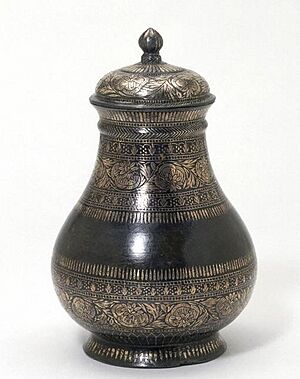
Bidri artists use a very special soil to blacken their creations. This soil comes from a 15th-century fort in Bidar. The artists say that in certain parts of the fort, the soil never gets sunlight or rain for many years. This gives the soil its unique properties. When artists look for this soil, they even taste it to find the right kind! The fort is a popular place for tourists, and it's protected. The guards usually don't mind if artists take small amounts of this special soil.
Scientists have studied this soil. They found it has a lot of alkaline nitrates. It's believed that these nitrates help turn the copper in the brass into copper(II) oxide, which is black. Sunlight can break down nitrates, which explains why the soil in sheltered parts of the fort is so rich in them.
New Ideas and Designs
This beautiful metal art is becoming popular again, thanks to new designs and patterns. Artists are creating items with both Indian and international themes. They are also making modern home and lifestyle accessories. The National Institute of Fashion Technology (NIFT) helps create these new designs. The Karnataka State Handicrafts Development Corporation Limited is also working hard to promote Bidri art.
This traditional art, which used to have only a few designs, is now trying to offer more variety. It wants to appeal to younger buyers and find its place in today's market. New items include covers for USB drives, office supplies like paper clips, keychains, lockets, pen holders, lampshades, and even floor tiles. The National Institute of Design has also come up with new, lighter items that use less silver, making them more affordable.
Bidriware in Other Places
While Bidar in Karnataka and Hyderabad in Telangana are the main places for Bidriware, this art is also practiced in other parts of India. You can find it in Purnia in Bihar, Lucknow in Uttar Pradesh, and Murshidabad in West Bengal. The designs in these places are often traditional, showing vines, flowers, and sometimes human figures.
In Bellori, a village near Purnia, local artists called Kansaris shape and turn the Bidri vessels. Then, goldsmiths called sonars do the engraving and polishing. You can also find a simpler version of Bidri called gharki here. In Lucknow, another type of Bidri work called Zar Buland is made, where the designs are raised above the surface.
In Aurangabad, the Bidri art was brought by the Nizam of Hyderabad. Since Aurangabad already had a rich history of art and craft, Bidri work quickly blended with the local styles there.
Researching Bidri Art
An artist from Gulbarga named Rehaman Patel has done a lot of research on Bidri art. He has gathered information about its history, how it's made, and looked at Bidri collections in museums in India and other countries. He also wrote about the Bidri artists themselves. Patel was a fellow of the Karnataka Shilpakala Academy Bangalore in 2014–15. He created a detailed document about "International collection of Bidri Art."
The Indian Royal Academy of Art and Culture published a book in Kannada called Karnatakada Bidri Kale (Bidri Art of Karnataka) in 2012. An English version about Bidri art was published in 2017.
|
See also
- Channapatna toys
- Dharwad pedha
- Kinnal Craft
- Mysore Sandal soap
- Navalgund durries
- Udupi Mattu Gulla


